Since its creation in 1992, the Premier League has become one of the most exciting, sought-after leagues in the world. In recent years, illustrious TV deals have meant being part of the Premier League is more important than ever. Clubs now seemingly have bottomless pockets and breaking the transfer record each window is the norm.
Whilst Premier League owners are willing to splash the cash, success is not a given. Many clubs in the last few years have proven that increased spending does not necessarily mean more points. There is now a greater onus on player recruitment, to find the best possible players available. One club who have had mixed player recruitment, in the last few years, is Tottenham Hotspur. Tottenham have been successful in transfer windows, bringing in players such as Lucas Moura and Heung-min Son. However, there have also been questionable additions. Clinton N’Jie and Georges-Kévin Nkoudou were brought in for a combined £20 million, however have only mustered 19 appearances between them.
Tottenham owner, Daniel Levy, is known for his stringent approach to transfers and has done so with success. Tottenham have finished in the top four for the last four seasons. However, Mauricio Pochettino has now left and the special one, José Mourinho, is at the helm. With their new manager, a new stadium and new approach to the game, Tottenham will be hoping this is their turning point. The purpose of this data analysis is to highlight key recruitment areas for Tottenham in a bid to break the ‘glass ceiling’ and top the Premier League for the first time in their history. Highlighting areas of weakness in the current squad will be a key part of this analysis. However, the first step is to understand the type of players Mourinho will need to build his title-winning squad.
2019/20 season
At the time of writing Mourinho has just come off the back of the worst non-winning streak of his career, with no wins in seven games. Of course, it will take time for Mourinho to instil his philosophy, and the rest of this season will be a chance for him to do so.
Since joining Tottenham, his approach has been clear. As highlighted in a previous analysis by my colleague Domagoj Kostanjšak, Tottenham have moved towards a direct, long-ball approach. Under Pochettino, Tottenham averaged 65% possession each match, whereas under Mourinho it sits closer to 47%. It is well known that Mourinho likes his teams to be compact, however, the most noticeable changes seem to be in Tottenham’s attacking phase of play. Tottenham often set up with a 4-2-3-1 formation, but transition into a 3-5-2 when attacking.
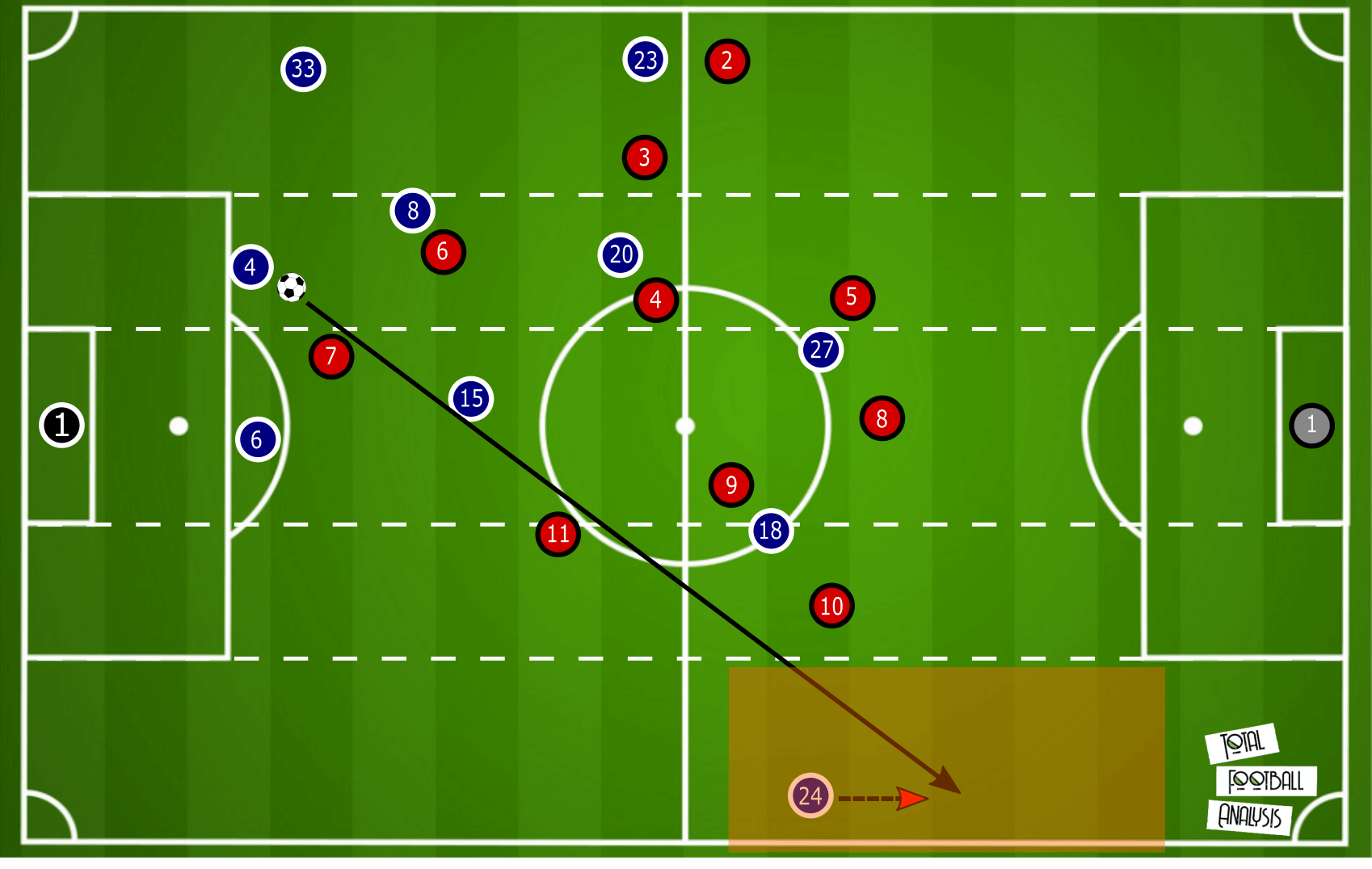
The image above, provided by Domagoj Kostanjšak, shows how Tottenham typically line up. Serge Aurier, 24, positions himself high and wide whilst the left-back, Ben Davies, drops in to form a back three. This approach for Mourinho has been very successful, as he allows his central defenders to switch the ball to find the full-backs in space. Below we can see a heat map from Serge Aurier, which highlights his average positioning. We can see a large majority of his time is spent high up the pitch, as shown in the line-up above.
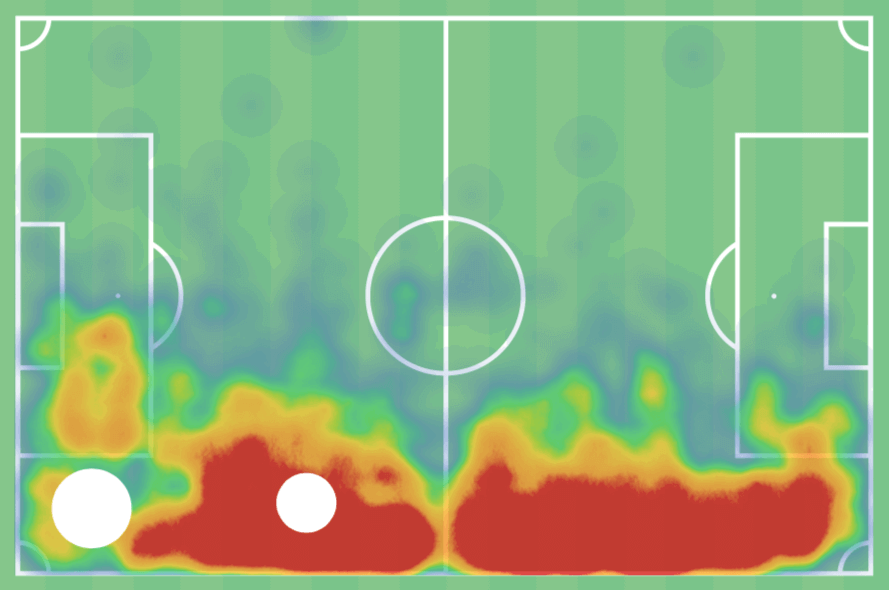
These tactics may be an accumulation of several things. Firstly, Mourinho has had limited options in central midfield due to injuries to Tanguy Ndombele and Moussa Sissokho. His latest idea to move Eric Dier to centre-back has also limited his options. Secondly, Mourinho has often displayed his desire to have his central midfielders as close to the defensive line as possible. This adds defensive solidity to his team, but also creates more space for when they utilise the direct approach.
Now we have an understating of the way Mourinho likes to set Tottenham up, we can start to analyse how successfully his current squad are performing. The following analysis will highlight some key areas in which Tottenham could improve. Firstly, we will consider the options Spurs currently have, and how they compare to their counterparts. We will then look to examine possible recruitment targets which could help Tottenham succeed in this style of play.
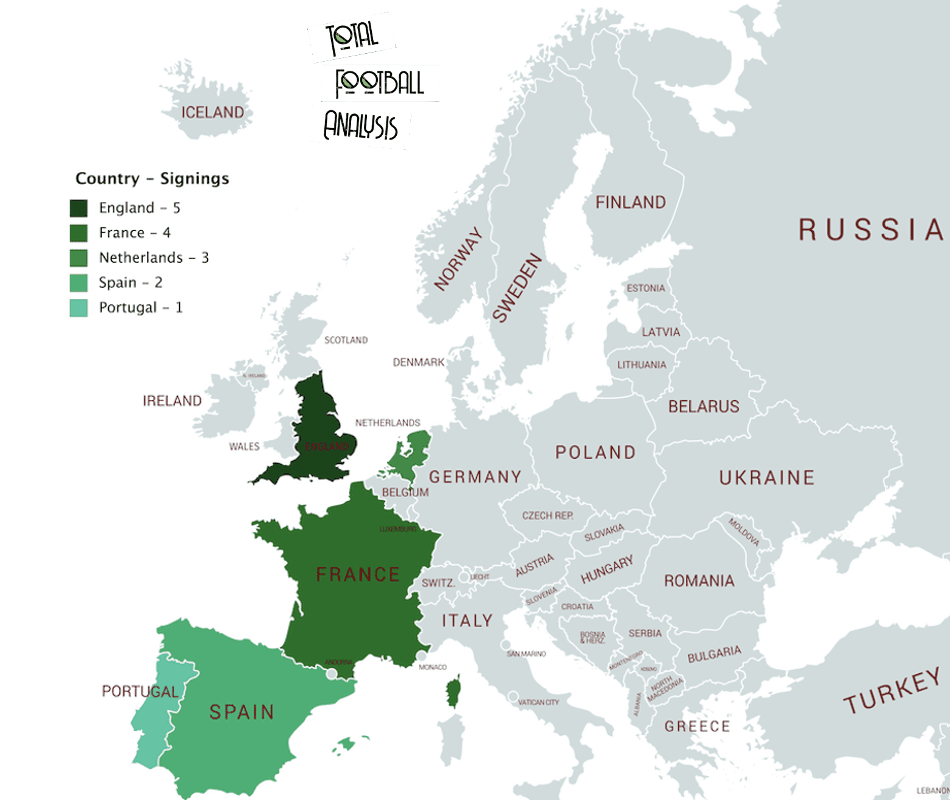
Before moving on to the recruitment analysis, it is important to understand the players we will be examining. In the last three seasons, Tottenham have conducted their recruitment in a range of areas. A majority of their business has come from England, with five signings. They have also utilised the French and Dutch markets. Therefore, all potential targets will be players from the top divisions in the English, French and Dutch leagues. Players from the top four, in the Premier League in the 2018/19 season, have been removed due to the unlikeliness of transfer business between clubs. All players must have played at least 10 games this season and be currently aged 20-27.
Areas of recruitment
The first position we are going to examine is right-back. As discussed, Tottenham use a system that pushes their right-back far up the pitch. Mourinho has used Aurier a lot in this system, however, we will now compare how Aurier fairs to the other right-backs.
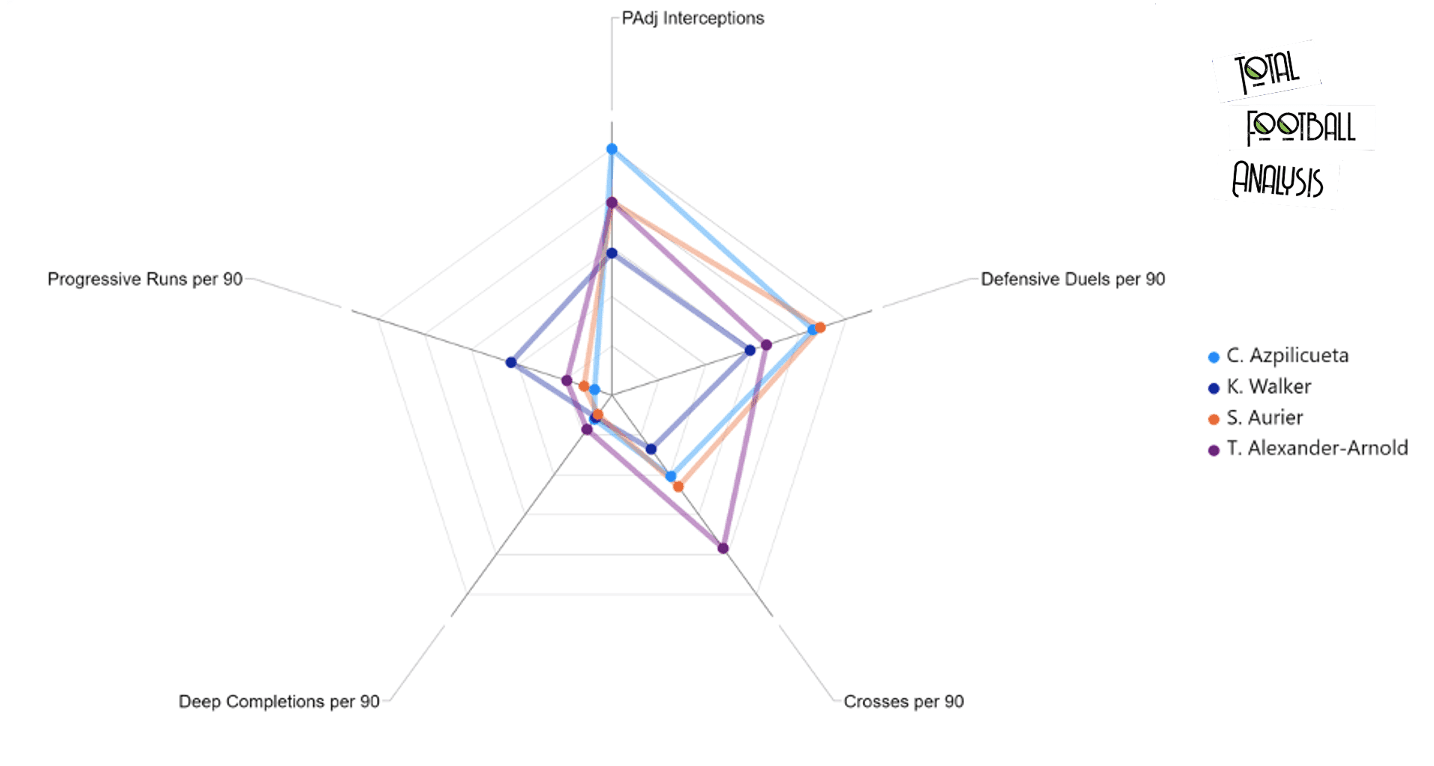
Above, we can see how Aurier compares, this season, to the right-backs from the top four teams in the 2018/19 season. The metrics compared look at a range of skills required from a full-back. Firstly, we can see that Trent Alexander-Arnold is way out in front with the most crosses with 6.98 per 90. Aurier is behind him in this area with 4.17 per 90. Another of our attacking metrics is deep completions per 90. This is a key metric for Tottenham’s system, as it will consider how many times the ball has been played into the opposition box. Again, Alexander-Arnold leads with 1.56 per 90. Aurier has the lowest deep completions per 90 with 0.88. Aurier also has a low number of progressive runs per 90 with 1.08. The top two scored very highly in this area, with Alexander-Arnold completing 1.75 per 90. Manchester City’s Kyle Walker is also very strong in this area, completing 3.91 per 90.
From a defensive aspect, Aurier performs quite well. He has the most defensive duels per 90, with 8.08. The Ivorian also has a high number of PAdj interceptions, with 7.12, only beaten by Chelsea full-back Azpilicueta who has 9.08. This tells us that Aurier is defensively sound, something Mourinho will be looking for. However, as Mourinho aims to use his full-back as a winger, he will require a much greater attacking output.
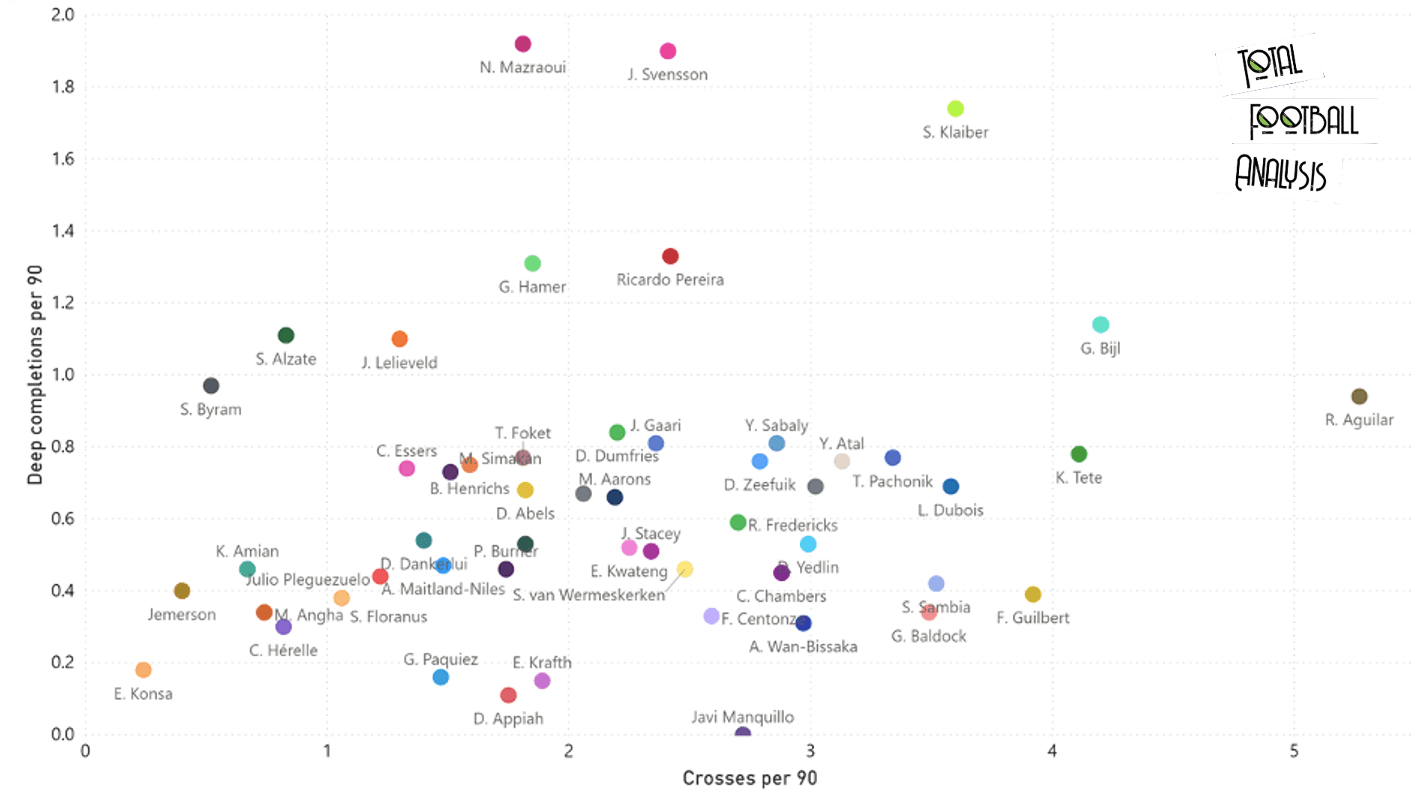
Now we can look at possible replacements that Mourinho could utilise to improve his teams attacking product. The scatter chart above compare’s right-backs from our chosen leagues, on two attacking metrics from earlier on, deep completions and crosses. We will highlight several players who stand out in these areas. Firstly, is Ruben Aguilar from AS Monaco FC. The 27-year old has the most crosses of all players, with 5.27 per 90. The French full-back also has a good amount of deep completions, with 0.94 per 90.
Next, we have the first of our three Eredivisie full-backs. Sean Klaiber is a 25-year old full-back contracted to FC Utrecht. The Dutch full-back has a high number of crosses per 90 with 3.60. The 25-year old also has a high number of deep completions with 1.74 per 90. Our next player is Norwegian full-back, Jonas Svensson. Originally a midfielder, the Norwegian has taken his attacking pedigree into defence, completing 2.41 crosses and 1.90 deep completions per 90. A similar player is 22-year old Ajax full-back Noussair Mazraoui. Whilst opportunities have been limited due to the impressive Sergiño Dest, he still has the most deep completions with 1.92 per 90. Mazraoui doesn’t score too highly in crosses with only 1.81 per 90.
Another player from Eredivisie is Glenn Bijl from FC Emmen. Bijl has a high number of crosses per 90 with 4.20. The Dutch full-back also has 1.14 deep completions per 90, giving him the sixth most out of all the players. Lastly, we have a Dutch full-back plying his trade in Ligue 1. Kenny Tete, previously of the Eredivisie, has a good number of crosses per 90 with 4.11. His deep completions are slightly lower than the other players analysed, with only 0.78 per 90.
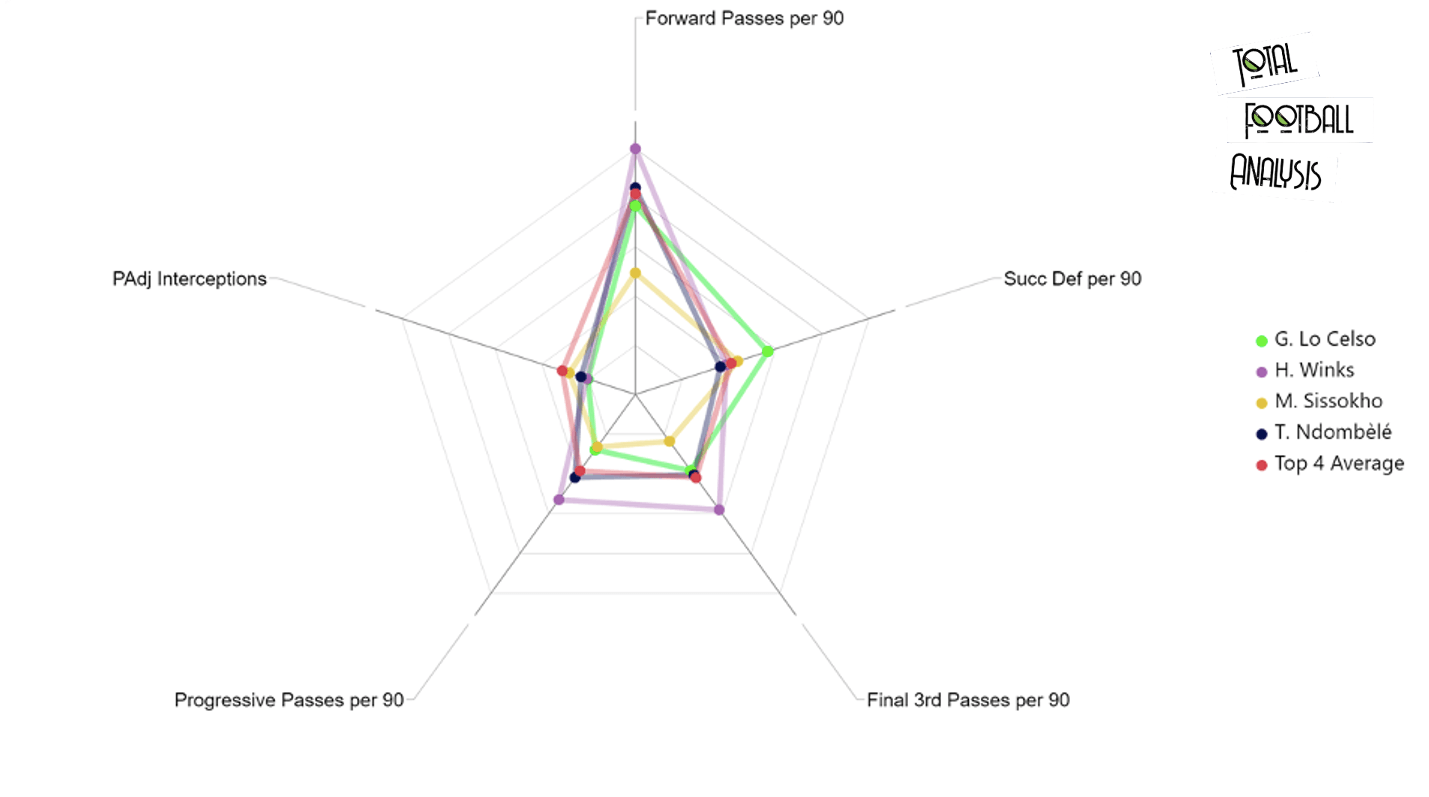
Next, we will look at players who will provide defensive stability to Tottenham. As discussed, Mourinho likes his central midfielders to protect the defence and often bypasses them in his attacking build-up.
Above we have examined how the current Spurs central midfielders compare, this season, to the average of all midfielders from the top four teams in 2018/19 season. The above analysis has compared several metrics on a defensive and attacking basis. Firstly, it becomes clear that Tottenham have a very accomplished midfielder in Harry Winks. Winks scores highly on many of the attacking metrics. The England midfielder attempts 19.45 forward passes per 90, completing over 80% of these. Winks also tops the chart in progressive passes, with 10.3 per 90, and final third passes with 11.29 per 90. Clearly Winks is very accomplished in the attacking phases of play. However, Mourinho’s new approach is somewhat starving Winks of the ball, as his average touches per 90 went from 92 to 78.
When examining defensive output, we see that many of the Tottenham midfielders are below the top four average. Giovanni Lo Celso scores very highly on successful defensive actions per 90, with 11.02. This is much higher than his teammate Moussa Sissokho and the top four average, as they complete 8.52 and 7.97 per 90, respectively. When it comes to PAdj interceptions, all of the Spurs midfielders are below the top four average. The midfielders from the top four average 6.08 PAdj interceptions per 90, whereas the highest for Tottenham is Moussa Sissokho with 5.51 per 90. These statistics will alarm Mourinho as he looks to build a defensively sound team.
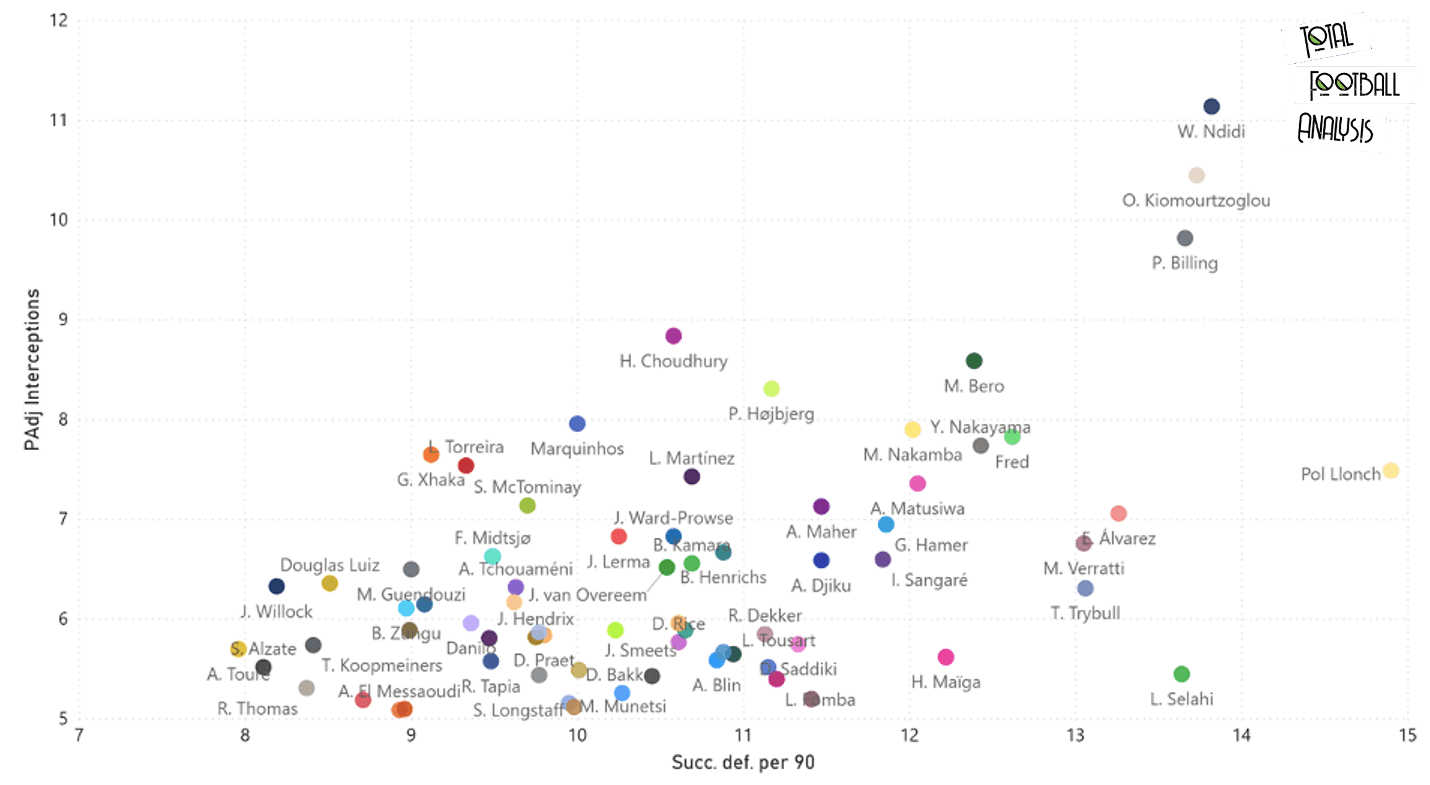
We will now consider possible options that Mourinho could utilise to add a more defensive structure to his squad. This analysis will use two of the defensive metrics we used to compare the current Spurs midfielders.
Four players have been highlighted in this area. Firstly, we have the Nigerian, Wilfred Ndidi of Leicester City. Ndidi has had an exceptional year in the Premier League, and sits top with the most PAdj interceptions with 11.14 per 90. The 23-year old also scores highly in successful defensive actions, completing 13.82 per 90. Leicester City are becoming a very accomplished team in the Premier League so capturing Ndidi’s signature may prove difficult. Remaining in the Premier League, we have Bournemouth midfielder, Phillip Billing. Billing has similar statistics to Ndidi, as he completes 9.82 PAdj interceptions and 13.66 defensive actions per 90.
The next two players highlighted are both from the Eredivisie. 22-year old Orestis Kiomourtzoglou currently plays for Heracles Almelo. The young German is certainly defensive-minded as he completed an average of 13.73 successful defensive actions per 90. The 22-year old also has a high number of PAdj interceptions with 10.45 per 90. Another highlighted player is also from the Eredivisie. Pol Llonch, of Willem II, also has good defensive statistics. He has by far the most successful defensive actions, with 14.90 per 90. The 27-year old Spaniard also has an impressive number of PAdj interceptions with 7.49 per 90.
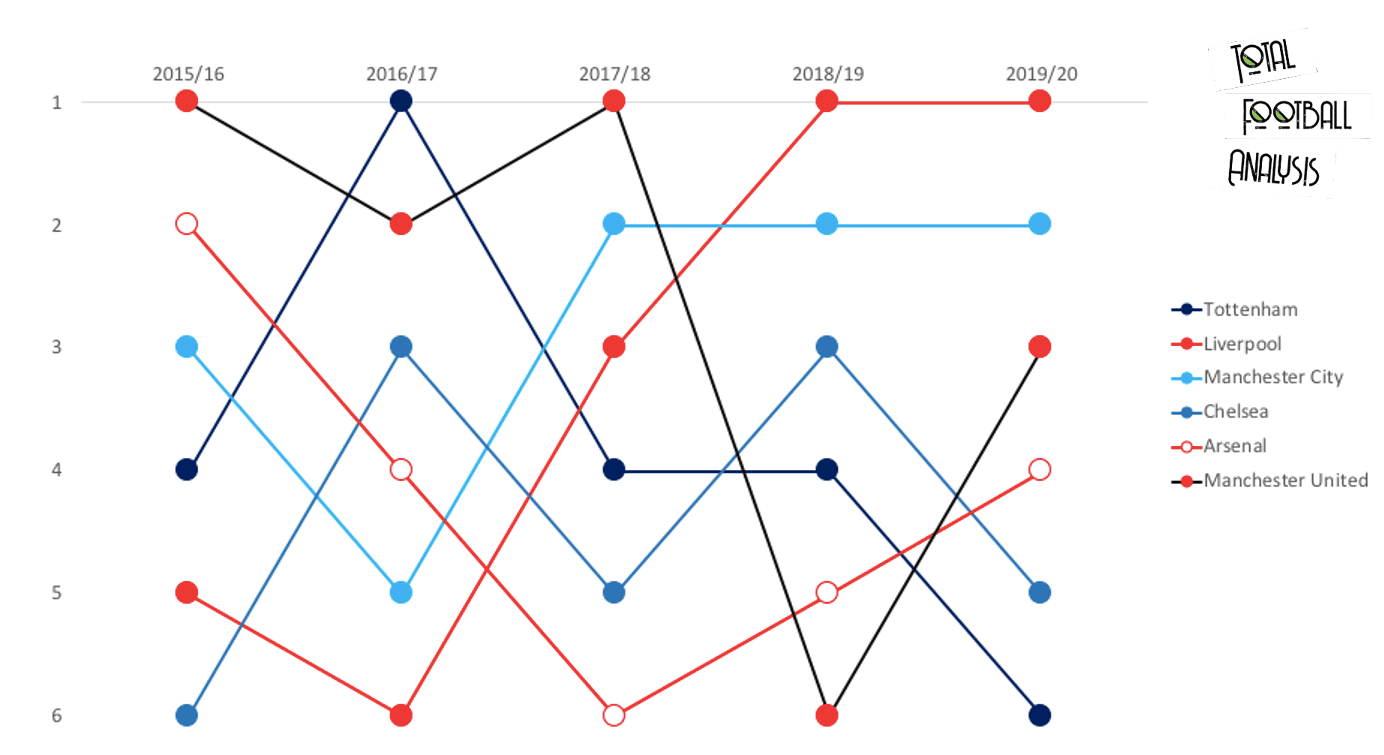
Finally, we will look at an area that has been Tottenham’s Achilles heel this season. Above we can see the ranking of the number of clean sheets for the ‘big 6’ in the Premier League. In the past four previous seasons, Tottenham have had at least 13 clean sheets. This season, 31 games in, Spurs only have five clean sheets. Clearly a big issue for Mourinho to fix. Interestingly, in the seasons Mourinho was at Manchester United, they finished first (2017/18) and second (2016/17) in the number of clean sheets.
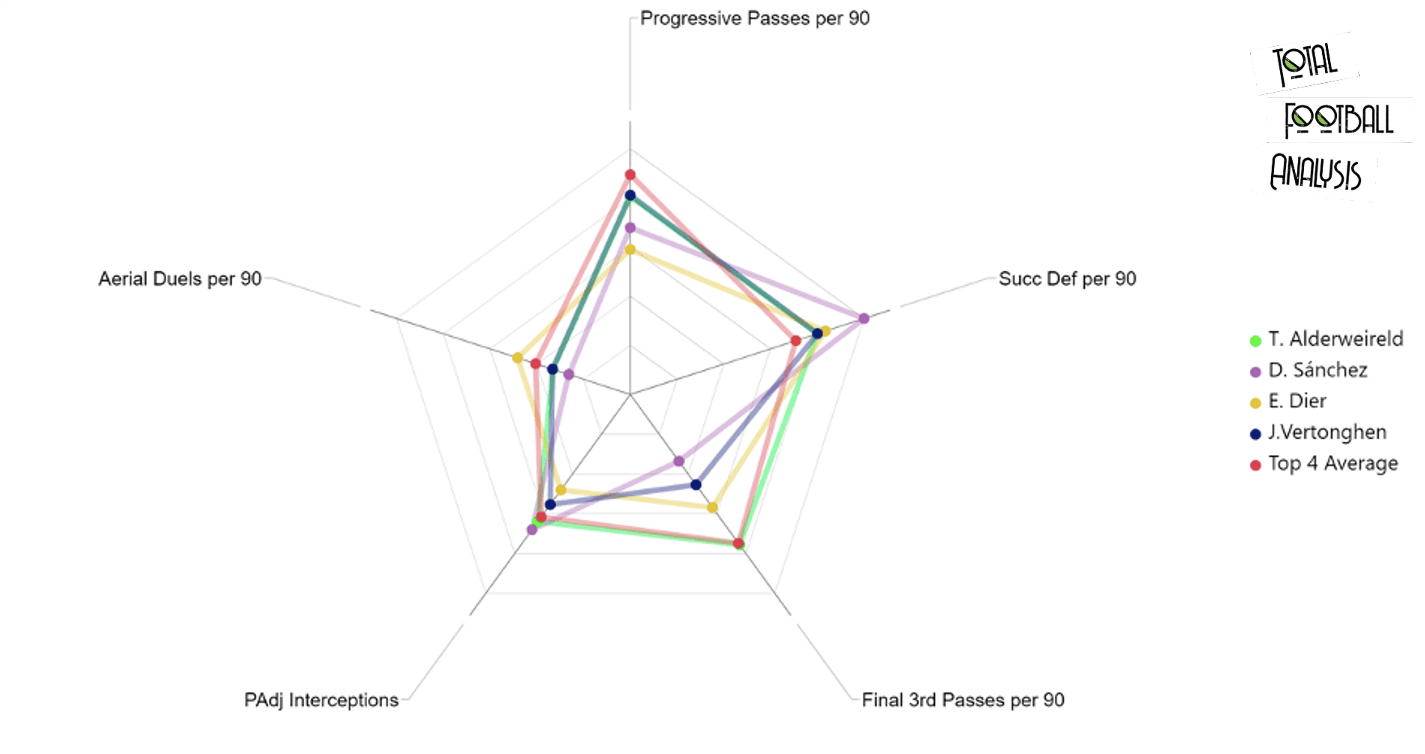
The above analysis looks how the current Spurs central defenders compare, this season, to the top four from the 2018/19 season. Interestingly, Spurs defenders have a low number of progressive passes per 90, compared to the top four who average 10.33 per 90. The Spurs defender who attempts the most progressive passes per 90 is Vertonghen with 9.36. Toby Alderweireld does have a high number of final third passes with 8.73 per 90.
Defensively, Davinson Sánchez performs very well. He has the most PAdj interceptions with 7.86 and also the most successful defensive actions with 11.55 per 90. A majority of the Spurs defence have fewer aerial duels than the top four average, 4.86, apart from Eric Dier with 5.57 per 90. Dier’s recent transition to centre-back highlights Mourinho’s concern that he does not have enough quality in this area. Vertonghen’s imminent departure will also leave Mourinho with fewer options.
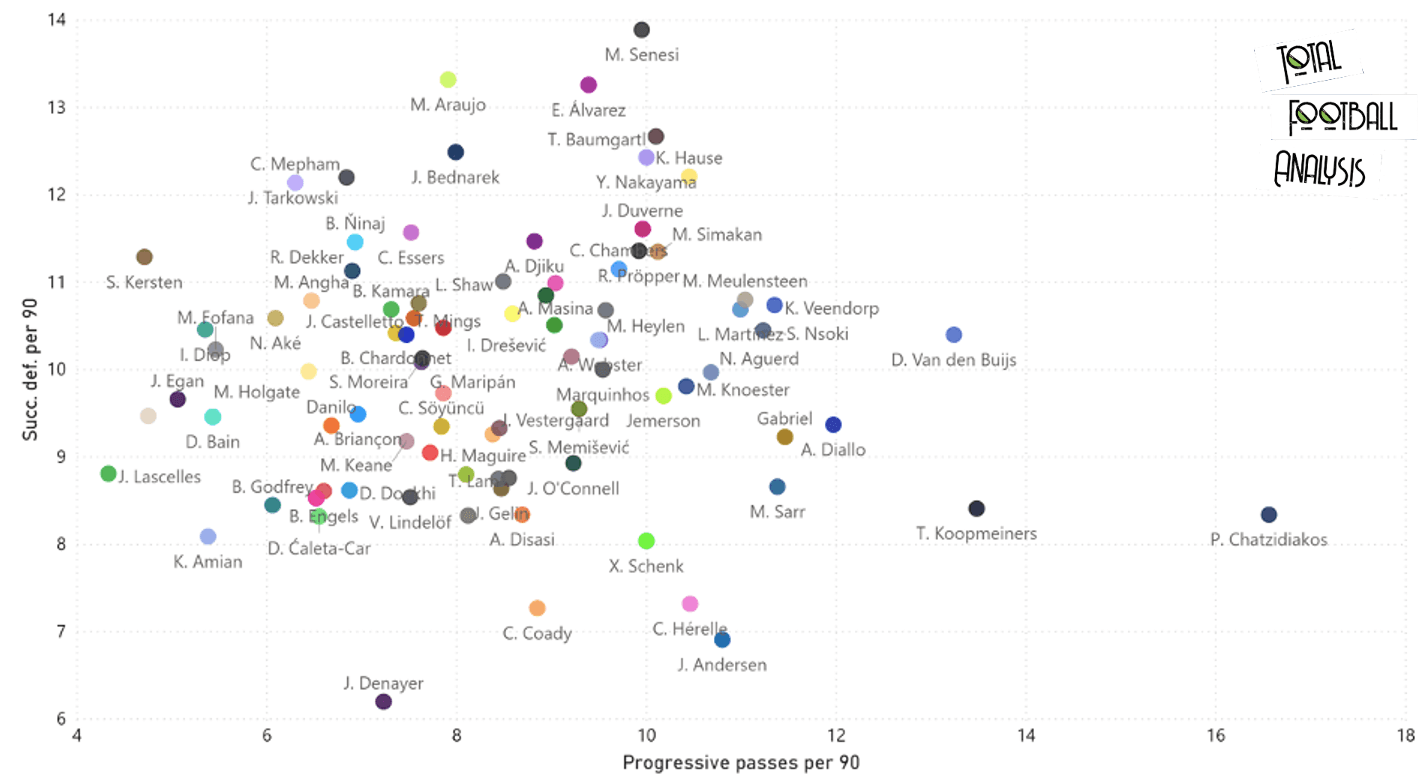
We will now examine central defender options to help bolster Mourinho’s defence. As mentioned, Vertonghen may be on his way out and Tottenham need to stop leaking goals. For this reason, we will examine a passing and defensive action to find suitable players.
Firstly, we will highlight AZ Alkmaar defender Pantelis Chatzidiakos. The Greek defender is only 23 but has highlighted impressive attacking output. Chatzidiakos has attempted 16.56 progressive passes per 90, completing 78.23% of these. Clearly the 23-year old Greek is very comfortable with the ball. He also has 8.34 successful defensive actions per 90, slightly lower than the other players examined.
Another player from AZ Alkmaar is Teun Koopmeiners. Koopmeiners is primarily a defensive midfielder but transitioned to a central defender towards the end of the season. The 22-year old is very similar to his AZ Alkmaar teammate, Chatzidiakos, as he attempts 13.48 progressive passes per 90, completing 78.63% of those. Defensively he is also very similar with 8.41 successful defensive actions per 90.
On the other end of the spectrum, we have some players who have a greater defensive output. Firstly, we have 23-year old Marcos Senesi from Feyenoord. The Argentinian has the highest number of successful defensive actions of all players, with 13.89 per 90. Senesi also has a good number of progressive passes per 90 with 9.95, higher than any current Spurs defender.
Tottenham acquired current defender Davinson Sánchez from Ajax, and now the Eredivisie club have a new possible star. Mexican, Edson Álvarez has had limited opportunities and has often played as a defensive midfielder. However, his prime position is centre-back which shows with his high number of successful defensive actions (13.26). The 22-year old is also very comfortable with the ball, as he attempted 9.39 progressive passes per 90, completing 84.13% of those.
Conclusion
So, we have used data to examine possible transfer targets for Tottenham to help them build on their success in the last few years. Of course, the data only paints part of the picture and in-depth analysis of each player would be required to understand their real quality.





Comments